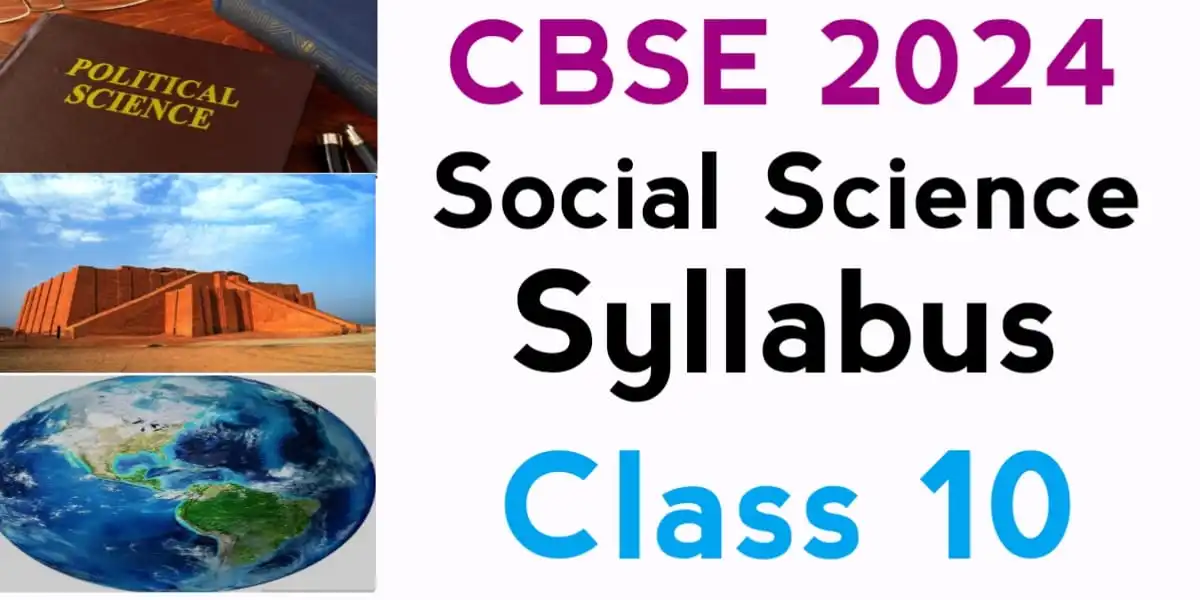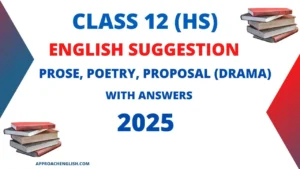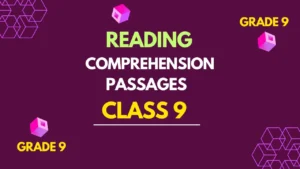The CBSE Social Science Syllabus Class 10 2023-24 has been annunciated which encourages students to go beyond rote memorization. It can be downloaded for free from the following download link.
It places a strong emphasis on critical thinking, urging students to analyze historical events, dissect economic trends, understand political structures, and appreciate the interconnectedness of societal elements.
The CBSE Class 10 Social Science syllabus is a comprehensive guide that serves as a roadmap for students, educators, and parents alike.
Class 10 CBSE Social Science Syllabus 2023-24
It offers a detailed insight into the course structure, content, question paper design, internal assessment, and the intriguing component of map work for the upcoming academic session.
The foundation of any effective syllabus lies in its structure. The Class 10 Social Science syllabus is meticulously organized, ensuring a systematic flow of topics across subjects like History, Geography, Civics, and Economics.
Related Topics
Download Class 10 CBSE Social Science Syllabus 2023-24
Empower your learning experience by downloading the Class 10 CBSE Social Science Syllabus 2023-24 in PDF format.
This comprehensive document outlines the curriculum, providing insights into historical events, geographical phenomena, political processes, and societal dynamics. Access the PDF to navigate the fascinating landscape of social sciences with clarity and depth
This structure not only aids in a smooth learning progression but also facilitates a holistic understanding of the diverse realms of social sciences. Let’s explore them.
Course Structure for CBSE Social Science Syllabus Class 10 2023-24
History (India and the Contemporary World – II)
| Section | Chapter No. | Chapter name | No. of periods | Marks allocated |
| Events and processes | I | The Rise of Nationalism in Europe | 17 | 18 + 2 map pointing * |
| Events and processes | II | Nationalism In India | 17 | 18 + 2 map pointing * |
| II Livelihoods, Economies and Societies | III | The Making of a Global World (To be evaluated in the Board Examination – Subtopics:1 to 1.3 Pre Modern World to Conquest, Disease and Trade) Interdisciplinary project as part of multiple assessments (Internally assessed for 5 marks Sub topics 2 to 4.4 The nineteenth century (1815-1914) to end of Bretton Woods & the beginning of “Globalisation.” | 6 4 | 18 + 2 map pointing * |
| II Livelihoods, Economies and Societies | IV | The Age of Industrialization (To be assessed as part of Periodic Assessments only) | 6 | |
| III Everyday Life, Culture and Politics | V | Print Culture and the Modern World | 10 |
Geography (Contemporary India – II)
| Chapter No. | Chapter Name | No. of Periods | Marks allocated |
| 1. | Resources and Development | 7 | 17 + 3 map pointing |
| 2. | Forest and Wildlife Resources | 7 | 17 + 3 map pointing |
| 3. | Water Resources | 7 | 17 + 3 map pointing |
| 4. | Agriculture | 10 | 17 + 3 map pointing |
| 5. | Minerals and Energy Resources | 10 | 17 + 3 map pointing |
| 6. | Manufacturing Industries | 10 | 17 + 3 map pointing |
| 7. | Lifelines of National Economy Only map pointing to be evaluated in the Board Examination | 2 | 17 + 3 map pointing |
| 8. | Interdisciplinary project as part of multiple assessments (Internally assessed for 5 marks) | 2 |
Political Science (Democratic Politics – II)
| Unit No. | Chapter No | Chapter Name | No. of Periods | Marks allocated |
| I. | 1. | Power – sharing | 15 | 17 + 3 map pointing |
| I | 2. | Federalism | 15 | 17 + 3 map pointing |
| II. | 3. | Gender, Religion and Caste | 12 | 17 + 3 map pointing |
| III | 4. | Political Parties | 12 | 17 + 3 map pointing |
| IV | 5. | Outcomes of Democracy | 11 | 17 + 3 map pointing |
Economics (Understanding Economic Development)
| Chapter No. | Chapter Name | No. of Periods | Marks allocated |
| 1. | Development | 12 | 20 |
| 2. | Sectors of the Indian Economy | 12 | 20 |
| 3. | Money and Credit | 12 | 20 |
| 4. | Globalisation and The Indian Economy To be evaluated in the Board Examination: What is Globalization? Factors that have enabled Globalisation Interdisciplinary project as part of multiple assessments (Internally assessed for 5 marks) Production across the countries Chinese toys in India World Trade Organisation The Struggle for a Fair Globalisation | 8 6 | 20 |
| 5. | Consumer Rights (Project Work) | 10 |
List of Map Iteams Social Science Syllabus Class 10
| Subject | Name of the Chapter | List of areas to be pointed on the Map |
| History | Nationalism in India | I. Congress sessions: 1920 Calcutta 1920 Nagpur. 1927 Madras session, II. 3 Satyagraha movements: Kheda Champaran. Ahmedabad mill workers III. Jallianwala BagIV. Dandi March |
| Geography | Resources and Development | Identify: Major Soil Types |
| Water Resources | Locating and Labelling: Salal Bhakra Nangal Tehri Rana Pratap Sagar Sardar Sarovar Hirakud Nagarjuna Sagar Tungabhadra | |
| Agriculture | Identify: Major areas of Rice and Wheat Largest/ Major producer states of Sugarcane, Tea, Coffee, Rubber, Cotton and Jute | |
| Minerals and Energy Resources | Identify: a. Iron Ore mines Mayurbhanj Durg Bailadila Bellary Kudremukh b. Coal Mines Raniganj Bokaro Talcher Neyveli c. Oil Fields Digboi Naharkatia Mumbai High Bassien Kalol Ankaleshwar Locate & label: Power Plants a. Thermal Namrup Singrauli Ramagundam b. Nuclear Narora Kakrapara Tarapur Kalpakkam | |
| Manufacturing Industries | I. Manufacturing Industries (Locating and Labelling only) ●Cotton Textile Industries: a. Mumbai b. Indore c. Surat d. Kanpur e. Coimbatore ●Iron and Steel Plants: a. Durgapur b. Bokaro c. Jamshedpur d. Bhilai e. Vijayanagar f. Salem ● Software Technology Parks: a. Noida b. Gandhinagar c. Mumbai d. Pune e. Hyderabad, f. Bengaluru g. Chennai. h. Thiruvananthapuram | |
| Lifelines of National Economy | Locating and Labelling: a. Major sea ports Kandla Mumbai Marmagao New Mangalore Kochi Tuticorin Chennai Vishakhapatnam Paradip Haldia b. International Airports: Amritsar (Raja Sansi – Sri Guru Ram Dass jee) Delhi (Indira Gandhi) Mumbai (Chhatrapati Shivaji) Chennai (Meenam Bakkam) Kolkata (Netaji Subhash Chandra Bose) Hyderabad (Rajiv Gandhi) |
Question Paper Design CBSE Social Science Syllabus Class 10
Subject Wise Weightage
| Subject | Syllabus | Marks (80) | Percentage |
| History | The Rise of Nationalism in Europe. Nationalism in India: The Making of a Global World Sub topics1 to 1.3 Print Culture and the Modern World Map pointing | 18+2 | 25% |
| Political Science | Power – sharing Federalism Gender, Religion and Caste Political Parties Outcomes of Democracy | 20 | 25% |
| Geography | Resources and Development Forest and Wildlife Resources Water Resources Agriculture Mineral& Energy resources Manufacturing industries. Lifelines of National Economy(map pointing) Map pointing | 17+3 | 25% |
| Economics | Development Sectors of the Indian Economy Money and Credit Globalization and The Indian Economy Sub topics: What is Globalization? Factors that have enabled Globalisation | 20 | 25% |
Weightage to Type of Questions
| Type of Questions | Marks (80) | Percentage |
| 1 Mark MCQs (20×1) (Inclusive Of Assertion, Reason, Differentiation &Stem) | 20 | 25% |
| 2 Marks Narrative Questions (4×2) (Knowledge,Understanding,Application,Analysis,Evaluation ,Synthesis & Create) | 8 | 10% |
| 3 Marks Narrative Questions (5×3) (Knowledge,Understanding,Application,Analysis,Eva luation,Synthesis & Create) | 15 | 18.75% |
| 4 MARKS Case Study Questions (3×4) (Knowledge,Understanding,Application,Analysis,Evaluatio n,Synthesis & Create) | 12 | 15% |
| 5 Mark Narrative Questions (4×5) (Knowledge,Understanding,Application,Analysis,Evaluatio n,Synthesis & Create) | 20 | 25% |
| Map Pointing | 5 | 6.25% |
Weightage to Competency Levels
| Sr. No. | Competencies | Marks (80) | Percentage |
| 1 | Remembering and Understanding: Exhibiting memory of previously learned material by recalling facts, terms, basic concepts, and answers; Demonstrating understanding of facts and ideas by organizing, translating, interpreting, giving descriptions and stating main ideas. | 24 | 30% |
| 2 | Applying: Solving problems to new situations by applying acquired knowledge, facts, techniques and rules in a different way. | 11 | 13.25% |
| 3 | Formulating, Analysing, Evaluating and Creating: Examining and breaking information into parts by identifying motives or causes; Making inferences and finding evidence to support generalizations; Presenting and defending opinions by making judgments about information, validity of ideas, or quality of work based on a set of criteria; Compiling information together in a different way by combining elements in a new pattern or proposing alternative solutions. | 40 | 50% |
| 4 | Map Skill | 5 | 6.25% |
| Total | 80 | 100% |
Guidelines for Internal Assessment:
| Type of Assessment | Description | Marks Allocated |
| Periodic Assessment | Pen Paper Test | 5 |
| Multiple Assessment | Quiz, debate, role play, viva, group discussion, visual expression, interactive bulletin boards, gallery walks, exit cards, concept maps, peer assessment, Selfassessment, etc. through Interdisciplinary project | 5 |
| Subject Enrichment Activity | Project Work on Consumer Rights OR Social Issues OR Sustainable Development | 5 |
| Portfolio | Classwork, Work done (activities/ assignments) reflections, narrations, journals, etc. Achievements of the student in the subject throughout the year Participation of the student in different activities like heritage India quiz | 5 |
Prescribed Textbooks
| Subject | Name of the Book | Publisher |
| History | India and the Contemporary World – II | NCERT |
| Political Science | Democratic Politics | NCERT |
| Geography | Contemporary India | NCERT |
| Economics | Understanding Economic Development | NCERT |
| Disaster Management | Together Towards a Safer India -Part III (A text book on Disaster Management) | CBSE |
The CBSE Class 10 Social Science syllabus for the 2023-2024 session is not merely a set of guidelines; it is a blueprint for a transformative educational journey.
By embracing the holistic approach, interactive learning, and a focus on contemporary relevance, students are well-equipped to navigate the complexities of social sciences and emerge as well-rounded individuals ready to contribute meaningfully to the world.
Related CBSE Class 10 Syllabus
FAQs
Is the new syllabus significantly different from the previous one?
The changes are notable, focusing on contemporary issues and providing a more comprehensive understanding of social sciences.
How can students access the revised syllabus for Class 10?
The updated syllabus is available on the official CBSE website for easy access.
Are there any changes in the examination pattern?
The examination pattern remains largely unchanged, with a focus on assessing students’ understanding and application of concepts.
What role do parents play in supporting students through these changes?
Parents can provide emotional support, create a conducive study environment, and actively engage in their child’s academic journey.







